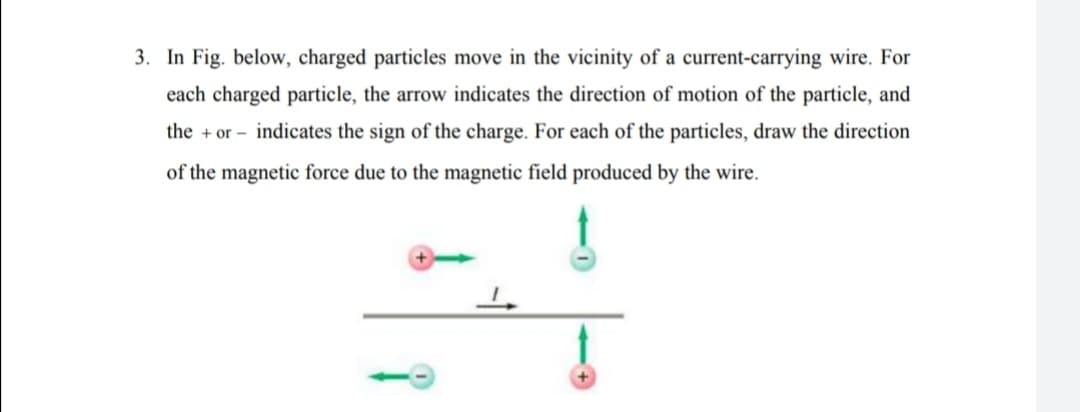3. In Fig. below, charged particles move in the vicinity of a current-carrying wire. For each charged particle, the arrow indicates the direction of motion of the particle, and the + or – indicates the sign of the charge. For each of the particles, draw the direction of the magnetic force due to the magnetic field produced by the wire.
3. In Fig. below, charged particles move in the vicinity of a current-carrying wire. For each charged particle, the arrow indicates the direction of motion of the particle, and the + or – indicates the sign of the charge. For each of the particles, draw the direction of the magnetic force due to the magnetic field produced by the wire.
Physics for Scientists and Engineers, Technology Update (No access codes included)
9th Edition
ISBN:9781305116399
Author:Raymond A. Serway, John W. Jewett
Publisher:Raymond A. Serway, John W. Jewett
Chapter30: Sources Of The Magnetic Field
Section: Chapter Questions
Problem 30.10OQ: Consider the two parallel wires carrying currents in opposite directions in Figure OQ3G.9. Due to...
Related questions
Question
100%
In Fig. below, charged particles move in the vicinity of a current-carrying wire. For
each charged particle, the arrow indicates the direction of motion of the particle, and
the or indicates the sign of the charge. For each of the particles, draw the direction
of the magnetic force due to the magnetic field produced by the wire.

Transcribed Image Text:3. In Fig. below, charged particles move in the vicinity of a current-carrying wire. For
each charged particle, the arrow indicates the direction of motion of the particle, and
the + or – indicates the sign of the charge. For each of the particles, draw the direction
of the magnetic force due to the magnetic field produced by the wire.
Expert Solution
This question has been solved!
Explore an expertly crafted, step-by-step solution for a thorough understanding of key concepts.
This is a popular solution!
Trending now
This is a popular solution!
Step by step
Solved in 2 steps with 1 images

Knowledge Booster
Learn more about
Need a deep-dive on the concept behind this application? Look no further. Learn more about this topic, physics and related others by exploring similar questions and additional content below.Recommended textbooks for you

Physics for Scientists and Engineers, Technology …
Physics
ISBN:
9781305116399
Author:
Raymond A. Serway, John W. Jewett
Publisher:
Cengage Learning

Glencoe Physics: Principles and Problems, Student…
Physics
ISBN:
9780078807213
Author:
Paul W. Zitzewitz
Publisher:
Glencoe/McGraw-Hill


Physics for Scientists and Engineers, Technology …
Physics
ISBN:
9781305116399
Author:
Raymond A. Serway, John W. Jewett
Publisher:
Cengage Learning

Glencoe Physics: Principles and Problems, Student…
Physics
ISBN:
9780078807213
Author:
Paul W. Zitzewitz
Publisher:
Glencoe/McGraw-Hill


College Physics
Physics
ISBN:
9781305952300
Author:
Raymond A. Serway, Chris Vuille
Publisher:
Cengage Learning

College Physics
Physics
ISBN:
9781285737027
Author:
Raymond A. Serway, Chris Vuille
Publisher:
Cengage Learning

Principles of Physics: A Calculus-Based Text
Physics
ISBN:
9781133104261
Author:
Raymond A. Serway, John W. Jewett
Publisher:
Cengage Learning